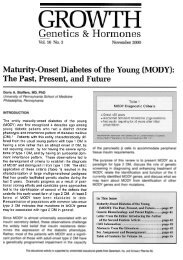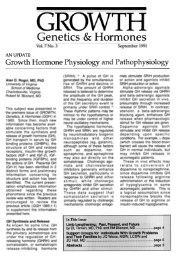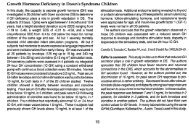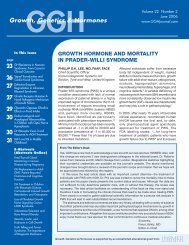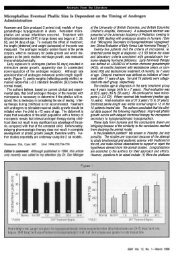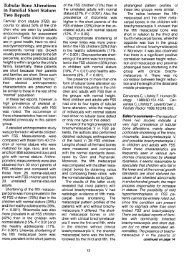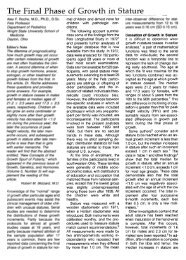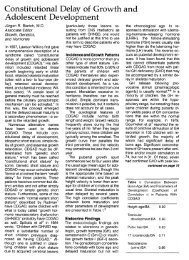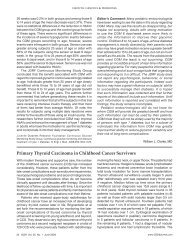occult celiac disease: a common cause of short stature - GGH Journal
occult celiac disease: a common cause of short stature - GGH Journal
occult celiac disease: a common cause of short stature - GGH Journal
Create successful ePaper yourself
Turn your PDF publications into a flip-book with our unique Google optimized e-Paper software.
Vol. 5 No.2 June 1989<br />
Asaria Ashkenazi, M.D.<br />
Associate Pr<strong>of</strong>essor <strong>of</strong> Pediatrics<br />
Director, Department <strong>of</strong><br />
Pediatrics B<br />
Kaplan Hospital, Rehovot<br />
Affiliated with the Medical School<br />
<strong>of</strong> the Hebrew University and<br />
Hadassah<br />
Jerusalem, Israel<br />
Failure to thrive in association with<br />
gastrointestinal (GI) symptoms is<br />
<strong>common</strong> in children with active <strong>celiac</strong><br />
<strong>disease</strong> (CD). In two studies 1,2<br />
<strong>of</strong> patients with GI symptoms due<br />
to CD, 36% and 55% were below<br />
the third centile for height, and<br />
40% and 60% were below it forweight.<br />
A small proportion (-5%)<br />
<strong>of</strong> CD patients with <strong>short</strong> <strong>stature</strong>,<br />
however, have no GI symptoms.<br />
They are considered to have <strong>occult</strong><br />
CD, which is quite important in<br />
the differential diagnosis <strong>of</strong> <strong>short</strong><br />
<strong>stature</strong>.<br />
Although gliadin-toxic peptides<br />
damage the intestinal mucosa in<br />
genetically susceptible individuals,<br />
the exact mechanism is not<br />
completely understood.3-S Current<br />
opinion favors the hypothesis that<br />
the harmful effects <strong>of</strong> gluten are<br />
mediated by immunologic processes.<br />
Immunologic reactions<br />
appear to playa part in the pathogenesis<br />
<strong>of</strong> CD, but the distinct<br />
mechanism-be it cellular immunity,<br />
humoral immunity, or a combination<br />
<strong>of</strong> the two-remains<br />
elusive.6<br />
Short Stature as the<br />
Presenting Symptom <strong>of</strong> CD<br />
Several investigators have reported<br />
<strong>short</strong> <strong>stature</strong> as the only<br />
manifestation in some cases <strong>of</strong> CD<br />
(Table).7-11 In one cohort7 <strong>of</strong> 796<br />
children and adolescents seen for<br />
growth retardation, 14 had CD<br />
(1.8%). Although the children with<br />
CD had no current GI symptoms,<br />
eight had a history <strong>of</strong> diarrhea during<br />
Etiology and Pathogenesis<br />
infancy. In another study, 34<br />
<strong>of</strong> CD<br />
patients with <strong>short</strong> <strong>stature</strong> <strong>of</strong> unde-<br />
Wheat gluten, specifically its gliadin<br />
fraction, is toxic to genetically<br />
susceptible individuals. In recentstudies,<br />
we demonstrated the In This Issue<br />
toxic effects <strong>of</strong> purified gliadin derived<br />
The Remarkable Catch-up<br />
from peptides; it was ob-<br />
Growth <strong>of</strong> American<br />
tained from intestinal mucosa cultures<br />
<strong>of</strong> CD patients ingesting a<br />
normal gluten-containing diet. The<br />
Slaves<br />
Letters to the Editor<br />
Editorial Comment<br />
page 4<br />
page 7<br />
page 10<br />
smallest toxic peptide had a molecular<br />
mass <strong>of</strong> 6,129 daltons and<br />
Abstracts ".".",."."..".., page 11<br />
Meeting Calendar page 16<br />
contained 53 amino acids.<br />
termined origin, but no GI symptoms,<br />
underwent jejunal biopsy for<br />
exclusion <strong>of</strong> <strong>celiac</strong> <strong>disease</strong>.8 Eight<br />
patients (24%) had subtotal or severe<br />
partial villous atrophy; seven<br />
<strong>of</strong> these patients showed signifi.,<br />
cant increases in height and<br />
weight velocity after switching to a<br />
gluten-free diet.<br />
In a group <strong>of</strong> 108 children with<br />
<strong>short</strong> <strong>stature</strong> <strong>of</strong> undetermined etiology<br />
referred to an endocrine clinic<br />
in Italy, 9 (8%) had CD.9 All<br />
patients with CD were diagnosed<br />
by a biopsy <strong>of</strong> the small intestine,<br />
and the specimen was obtained<br />
via the oral route. The investigators<br />
found that although no single<br />
screening test or combination <strong>of</strong><br />
tests identified all <strong>of</strong> these patients,<br />
an abnormal xylose test, the<br />
presence <strong>of</strong> anti reticular and/or<br />
antigliadin antibodies, and a history<br />
<strong>of</strong> diarrhea in the first 2<br />
years <strong>of</strong> life identified most cases<br />
<strong>of</strong> CD. In a similar study,1O 87<br />
children with <strong>short</strong> statlife (height<br />
> 2 SO below the mean for age<br />
and sex) underwent biopsy <strong>of</strong> the<br />
small intestine after other <strong>cause</strong>s<br />
<strong>of</strong> growth retardation had been<br />
ruled out. Although none had GI<br />
symptoms, four (5%) had CD.<br />
Another study, conducted in Israel,<br />
described <strong>short</strong> <strong>stature</strong> as a<br />
major manifestation <strong>of</strong> CD in older<br />
children.11 In 11 <strong>of</strong> 23 (48%) patients<br />
referred to a gastroenterologist<br />
after an extensive negative<br />
endocrine evaluation, CD was diagnosed<br />
by small-bowel biopsy.<br />
continued on page 2
Occult Celiac Disease<br />
continued from page 1<br />
No clinical or laboratory clues enabled<br />
the investigators to differentiate<br />
between the cases <strong>of</strong> <strong>short</strong><br />
<strong>stature</strong> due to <strong>occult</strong> CD and those<br />
due to other <strong>cause</strong>s. Equally unhelpful<br />
in differential diagnosis<br />
was the age at diagnosis, length <strong>of</strong><br />
follow-up prior to referral to the GIservice,<br />
and degree <strong>of</strong> bone-age<br />
retardation. Although abnormal<br />
stool-fat excretion was found only<br />
in children with CD, sensitivity waslow,<br />
and abnormal results were<br />
found in only four <strong>of</strong> nine patients<br />
tested. However, testing for the<br />
presence <strong>of</strong> microcytic anemia revealed<br />
that all <strong>of</strong> the children with<br />
CD, but none without the <strong>disease</strong>,<br />
were anemic. A positive history <strong>of</strong><br />
past GI problems, particularly diarrhea,<br />
during early childhood<br />
also was very helpful.<br />
The prevalence <strong>of</strong> CD is low in<br />
some studies (1.8%,7 8%,9 and<br />
5% 1°) but high in others (24%8 and<br />
48%11). This disparity may indicate<br />
that CD can be recognized<br />
and treated in some areas <strong>of</strong> the<br />
world at a younger age, when<br />
the malabsorption symptoms are<br />
more clear-cut and before severe<br />
stunting <strong>of</strong> growth occurs; in other<br />
regions, however, it tends to be<br />
diagnosed later, when <strong>short</strong> <strong>stature</strong><br />
is the more obvious problem.<br />
This varying prevalence may also<br />
reflect a real disparity between the<br />
incidence <strong>of</strong> CD and its mode <strong>of</strong><br />
presentation.<br />
Is CD-Induced Short Stature<br />
Occult?<br />
Detecting <strong>occult</strong> CD as a <strong>cause</strong> <strong>of</strong><br />
<strong>short</strong> <strong>stature</strong> is a function <strong>of</strong> pr<strong>of</strong>essional<br />
alertness ins<strong>of</strong>ar as the<br />
clinician considers this condition<br />
in a differential diagnosis. Data in<br />
the medical literature. as well as<br />
from our own experience, show<br />
that many CD patients with <strong>short</strong><br />
<strong>stature</strong> have a history <strong>of</strong> diarrhea at<br />
an early age and/or have microcytic<br />
anemia. Other diagnostic<br />
clues that may indicate CD include<br />
increased stool fat, antigliadin and<br />
antiendomysial antibodies. and<br />
low folate and serum ferritin<br />
levels.3-S In a few cases, however,<br />
there may be no clue to CD other<br />
than abnormal intestinal mucosa<br />
diagnosed by an orally obtained<br />
jejunal biopsy.<br />
Pathogenesis <strong>of</strong> Growth<br />
Retardation<br />
The <strong>cause</strong> <strong>of</strong> growth failure in children<br />
with CD has been the focus <strong>of</strong><br />
many investigations. Initial studies<br />
suggested secondary hypopituitarism<br />
might be the basis for<br />
the retarded growth.1, 12-14 Subsequent<br />
assessments, however,<br />
failed to substantiate growth hormone<br />
(GH) deficiency in most<br />
growth-impaired children with CD.<br />
On continued investigation, it became<br />
increasingly evident that a<br />
gluten-free diet could reverse this<br />
complication. This finding further<br />
emphasized the importance <strong>of</strong><br />
adequate and appropriate nutrition<br />
in maintaining normal linear<br />
growth.<br />
The effect <strong>of</strong> gluten ingestion on<br />
the growth pattern <strong>of</strong> CD patients<br />
is still unresolved. Is growth retardation<br />
induced by the effect <strong>of</strong><br />
the <strong>disease</strong> on the general nutritional<br />
status? That is, does malabsorption<br />
lead to malnutrition,<br />
which, in turn, leads to a decrease<br />
in weight and failure to gain<br />
height? Or, in addition, is there a<br />
direct effect <strong>of</strong> gliadin peptides on<br />
the GH-secreting apparatus, as<br />
well as on other hormones affecting<br />
growth, such as somatomedin?<br />
GH and CD<br />
Inadequate response <strong>of</strong> serum GH<br />
levels to insulin stimulation was re-<br />
ported by Hamilton in 1969 in one<br />
<strong>of</strong> five CD patients examined. 1 We<br />
have examined the plasma GH<br />
levels in response to insulin stimulation<br />
in CD patients on a normal<br />
gluten diet, in patients on a glutenfree<br />
diet, and in normal children<br />
<strong>of</strong> comparable age who served<br />
as controls (Figure).12 The CD<br />
children showed a lower GH response,<br />
as a group, than the normal<br />
controls. Also, serum GH response<br />
to insulin stimulation in the<br />
CD group consuming a normal<br />
gluten diet was significantly lower<br />
than in the CD group on the glutenfree<br />
diet. Similar results have been<br />
reported in other studies.1,7,13,14<br />
Somatomedin-C (Sm-C), a GHdependent<br />
growth factor modulated<br />
by nutrient status, is variable<br />
in CD patients.1s-17 We were unable<br />
to find a correlation between<br />
serum Sm-C levels in CD children<br />
and the diet consumed. As would<br />
be expected, some CD patients<br />
who had low Sm-C levels while on<br />
the normal gluten diet had increased<br />
levels while on a glutenfree<br />
diet. On the other hand, other<br />
patients had normal serum Sm-C<br />
levels while consuming a normal<br />
gluten diet. Data are accumulating<br />
to suggest that Sm-C may be a<br />
useful marker <strong>of</strong> nutritional adequacy<br />
in patients with inflammatory<br />
bowel <strong>disease</strong> 18,19 but not in<br />
patients with CD.<br />
Enhanced Enteric Losses and<br />
Nutritional Dwarfism<br />
Anyone or a combination ot the<br />
nutritional alterations may lead to<br />
nutritional dwarfing in CD patients.This<br />
may occur even in patients
who have an increased body<br />
weight/height ratio (i.e., <strong>short</strong> and<br />
plump patients).<br />
The basic defect in CD is destruction<br />
<strong>of</strong> the intestinal epithelial<br />
cell layer, with reactive production<br />
<strong>of</strong> intestinal cells up to seven times<br />
the normal rate. The net result is<br />
flattening <strong>of</strong> the intestinal mucosa;<br />
immature and damaged epithelial<br />
cells cover the surface. This blunting<br />
<strong>of</strong> the villi is instrumental in<br />
decreasing the absorptive surface<br />
<strong>of</strong> the intestine and producing<br />
malabsorption and malnutrition.3-s<br />
The nutritional status <strong>of</strong> these patients<br />
is further impaired by the<br />
defects in the intestinal epithelium<br />
that <strong>cause</strong> protein-losing enteropathy,<br />
and is aggravated by the<br />
desquamation <strong>of</strong> the epithelial<br />
cells and shedding <strong>of</strong> lymphocytes.<br />
The resultant loss <strong>of</strong> protein,<br />
DNA, and lymphocytes leads to<br />
hypoproteinemia and lymphopenia.<br />
CD patients also experience<br />
intestinal loss <strong>of</strong> zinc. There<br />
is a tendency toward lower serum<br />
zinc levels in the CD patients. but<br />
these levels are not low enough to<br />
produce clinical symptoms.<br />
Children with CD have impaired<br />
iron balance as well. Serum ferritin<br />
levels in CD patients are <strong>of</strong>ten sig-<br />
nificantly lower than in controls,<br />
and a gluten-free diet produces a<br />
definite rise toward normal levels.<br />
The low ferritin levels reflect impairment<br />
<strong>of</strong> iron absorption, as well<br />
as increased iron losses in the<br />
desquamating epithelial cells and<br />
lymphocytes. Additionally, the serum<br />
folate levels are significantly<br />
lower in the untreated CD patients<br />
and may result from a decrease in<br />
the folate absorption <strong>cause</strong>d by<br />
the impairment <strong>of</strong> the deconjugase<br />
enzyme present in the brush border<br />
<strong>of</strong> the intestinal epithelial cells.<br />
This enzyme facilitates absorption<br />
by splitting glutamic acid residues<br />
from the folate heptaglutamate in<br />
foods and reducing them to monoor<br />
diglutamates. However, it is well<br />
known that there is a sevenfold<br />
increase <strong>of</strong> cell turnover and in<br />
DNA synthesis in patients with CD.<br />
This regenerative effort by the<br />
crypt cells in active CD requires<br />
folic acid, an essential component<br />
<strong>of</strong> the enzymes involved in the synthesis<br />
<strong>of</strong> DNA. Thus, there is a<br />
decrease in folic acid absorption<br />
that parallels an increase in folic<br />
acid requirements for DNA synthesis<br />
in patients with active CD.<br />
The net result is decreased serum<br />
folate levels.<br />
3<br />
Diagnosis <strong>of</strong> CD<br />
Two factors are important to remember<br />
when considering <strong>occult</strong><br />
CD in the differential diagnosis <strong>of</strong><br />
<strong>short</strong> <strong>stature</strong>: 1) Studies show an<br />
increased incidence <strong>of</strong> CD among<br />
children hospitalized for examination<br />
<strong>of</strong> <strong>short</strong> <strong>stature</strong>; and 2) CD may<br />
be present even in the absence <strong>of</strong><br />
GI symptoms. A small-bowel bi-opsy,<br />
"the gold standard" for the<br />
diagnosis <strong>of</strong> CD, should be performed<br />
in all children examined for<br />
<strong>short</strong> <strong>stature</strong> who show a decrease<br />
in the body weight/height ratio,<br />
have a history <strong>of</strong> diarrhea during<br />
the first year <strong>of</strong> life, or present with<br />
hematologic abnormalities such<br />
as anemia.<br />
Summary<br />
CD is more <strong>common</strong> than idiopathic<br />
GH deficiency as a <strong>cause</strong> <strong>of</strong><br />
<strong>short</strong> <strong>stature</strong>. Thus, it is important<br />
to rule out this <strong>disease</strong> in children<br />
in whom there is no endocrinologic<br />
<strong>cause</strong> <strong>of</strong> <strong>short</strong> <strong>stature</strong>. CD should<br />
be suspected in patients who 1)<br />
fail to grow at normal rates and<br />
have a bone age that is delayed,<br />
particularly if by more than 4 years;<br />
or 2) have a bone age below that<br />
expected for height. Be<strong>cause</strong> abnormal<br />
absorption may not be detected<br />
by <strong>common</strong> tests even in<br />
known CD patients, an intestinal<br />
biopsy may be needed for diagnosis.<br />
Confirmation <strong>of</strong> CD as the<br />
<strong>cause</strong> <strong>of</strong> delayed growth should<br />
come from documentation <strong>of</strong><br />
catch-up growth in weight and<br />
height after institution <strong>of</strong> a glutenfree<br />
diet, the only treatment"-now<br />
available for CD.<br />
The original work was supported by a grant<br />
from DFG, West Germany.<br />
Editor's comment-One <strong>of</strong> the<br />
greatest enigmas in pediatrics today<br />
is why <strong>celiac</strong> <strong>disease</strong> is so<br />
prevalent in Europe and the Middle<br />
East (Israel, for example) but<br />
not in North America. There are<br />
many descendants <strong>of</strong> Europeans<br />
in North America, but the <strong>disease</strong><br />
is rare. Readers who have a tenable<br />
theory, particularly one with<br />
supporting data, are encouraged<br />
to write to the editors <strong>of</strong> Growth,Genetics,<br />
and Hormones.<br />
continued on page 4
Occult Celiac Disease<br />
continued from page 3<br />
Even though <strong>celiac</strong> <strong>disease</strong> is<br />
less frequent in our clinics than in<br />
those <strong>of</strong> Europe, we must remain<br />
alert to the possibility that any child<br />
with <strong>short</strong> <strong>stature</strong> <strong>of</strong> unexplained<br />
etiology may have <strong>celiac</strong> <strong>disease</strong>.<br />
Robert M. Blizzard, M. D.<br />
References<br />
1. HamiltonJRetal. OJMed1969;38:<br />
135-158.<br />
2. Young WF et al. Arch Dis Child 1971;<br />
46:421-436.<br />
3. Ashkenazi A et al. Immunology and<br />
Allergy Practice 1988; 1 0:227-234.<br />
4. Ashkenazi A et al. Immunology and<br />
Allergy Practice 1988;10:268-277.<br />
5. Ashkenazi A et al. Immunology and<br />
Allergy Practice 1988;10:315-323.<br />
6. Ashkenazi A et al. Front Gastrointest<br />
Res 1986;13:204-214.<br />
7. Verkasalo M et al. Helv Paediatr Acta<br />
1978;33:489-495.<br />
8. Groll A et al. Lancet 1980;2:<br />
1097-1099.<br />
9. Cacciari E et al. Lancet 1985;<br />
1:1469-1471.<br />
10. Stenhammar L et al. Eur J Pediatr<br />
1986;145:185-186.<br />
11. Rosenbach Y et al. Clin Pediatr<br />
(Phila) 1986;25:13-16.<br />
12. Pollack D. Doctoral dissertation,<br />
1976.<br />
13. Day Get al. Arch Dis Child 1973;<br />
48:41-48.<br />
14. Vanderschueren-Lodeweyckx M etal.<br />
Helv Paediatr Acta 1973;28:349-357.<br />
15. Lecornu M et al. Helv Paediatr Acta<br />
1978;33:509-516.<br />
16. Philips LS etal. N EnglJ Med1980;<br />
302:371-380.<br />
17. Philips LSetal. N EnglJ Med1980;<br />
302:438-446.<br />
18. Kirschner BS et al. Gastroenterology<br />
1986;91 :830-836.<br />
19. Unterman TG et al. AmJ Med1985;<br />
78:228-234.




